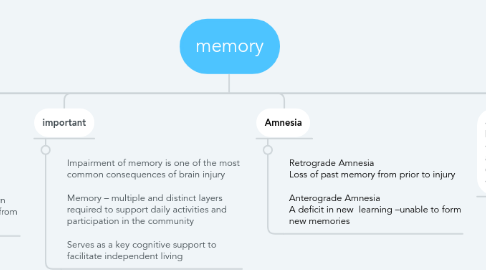
1. Declarative memory
1.1. Recollections that can be easily verbalised COgnitive, ecpliit, conscious memory Requires attention during recalll )not required for emtional and procedural)
1.2. Immediate/sensory register Losts 1-2 s Info processed through primary sensory and sensory associations Does not involve the limbic system
1.3. Short-term memory Brief storage of stimuli that have been recognised Loss of info ocurs within 1 min unless continually rehearsed
1.4. Working memory is the effortful deployment of cognitive resoures during this stage
1.4.1. Working memory is the effortful deployment of cognitive resources during this stage For input from sensory registers to proceed to storage in long term memory it must be subject to deliberate working for approximately 30 seconds. Capacity of 7 +/– 2 chunks of information It is also the seat of conscious thought used in concentration and problem solving It reflects the contribution of attention to memory (Lezak, 1995)
1.5. Long-term memory Relatively permanent stages of info that has been processed in short-term memory Conversation from short term to long term memory is called consolidation
1.6. Holds factual information subdivided into:
1.7. Episodic memory (knowledge of personal information and events)
1.8. Semantic memory (knowledge of facts about the world)
1.9. Memory deficits: Declarative- problems with episodic (remembering the days events, what happened in therapy session, what had for breakfast) and semantic- dates of holidays, name of prime minister, date of world events
2. Procedural memory
2.1. Practice is required to store procedural memories Once the skill is learned, less attention is required while performing the task Three stages of learning motor skills Cognitive Associative Autonomous
2.2. Definition: remembering that something has to be done at some point in the future, without any prompting in the form of explicit recall instructions Is a critical component of independent living Relies on frontal lobe and places high demand on working memory
2.3. Memory deficits Procedural- driving, playing sport, learning to use equipment
3. Emotional memory
3.1. Involves the amygala Damage to other types of memory does not affect emotional system Feeling elated, fearful smell of baking and memory with Nana
4. Post traumatic amnesia
4.1. Post-traumatic amnesia (PTA) is a state of confusion that occurs immediately following a traumatic brain injury (TBI) in which the injured person is disoriented and unable to remember events that occur after the injury. The person may be unable to state his or her name, where he or she is, and what time it is. While PTA lasts, new events cannot be stored in the memory
5. Prospective memory-
5.1. Memory deficits
5.1.1. remembering to take medications, return phone calls, buy food, pick up children from school, pay bills.
6. important
6.1. Impairment of memory is one of the most common consequences of brain injury Memory – multiple and distinct layers required to support daily activities and participation in the community Serves as a key cognitive support to facilitate independent living
7. Amnesia
7.1. Retrograde Amnesia Loss of past memory from prior to injury Anterograde Amnesia A deficit in new learning –unable to form new memories
8. -Most common consequences of brain injury -required to support daily activities and participation in the community -facilitate independent living
9. Cortical areas involved in learning a motor sequence
9.1. Motor and parietal cortex and striatum Learn Learned motor sequence representation located in the supplementary motor area and putamen/globus pallidus Motor adaptation (adjust to environmental changes) involves cerebellum and parietal cortex and motor cortex
10. Refers to recall of skills and habits Often called skill, habit, non-conscious memory, or implicit memory Implicit memory produces changes in performance without conscious awareness Riding a bike: Declarative memory Procedural memory
11. Hippocampus Involved in declarative memory Temporary storage-leads to memory solidation Temporal and spatial nativigation Also assists with assocative learning Cerebellum Involved with skills, conditioning, procedural memory
11.1. Cortical areas involved in learning a motor sequence Learning the sequence: motor and parietal cortex and striatum Learned motor sequence representation located in the supplementary motor area and the putamen/globus pallidus Motor adaptation (adjust to environmental changes) involves cerebellum and parietal cortex and motor cortex
12. Memory refers to information storage and retrieval (Lezak, 1995). Memory is the capacity to store experiences and perceptions for recall and recognition Learning is the acquisition of new information – memory is the retention of learned information
12.1. Process/steps of memory
12.1.1. Attend: brainstem, thalamic structures and frontal lobes Encode: dorsomedial thalamus, frontal lobes, language system,, vidual system eg association areas Store hippocampusl bilateral medial temporal lobes Retrieve frontal lobe
12.1.1.1. Encoding Aids (assist with storing)
12.1.1.1.1. Meaning (semantics) Imagery Mnemonics memory aids method of loci Chunking organising items into familiar, manageable units use of acronyms Hierarchies Organisation of knowledge under narrower concepts/headings Rehearsal conscious repetition of information
12.1.1.2. Retrieval
12.1.1.2.1. Recall retrieve information learned earlier Recognition identify items previously learned
12.1.2. Forgetting
12.1.2.1. Interference Proactive (forward-acting) interference Retroactive (backwards-acting) interference

